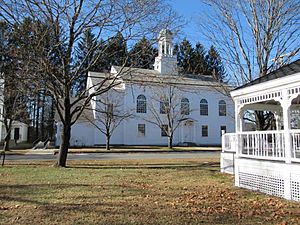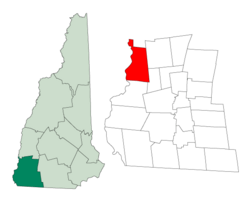Walpole, New Hampshire facts for kids
Quick facts for kids
Walpole, New Hampshire
|
|
|---|---|
|
Town
|
|

Town Hall in 2019
|
|

Location in Cheshire County, New Hampshire
|
|
| Country | United States |
| State | New Hampshire |
| County | Cheshire |
| Incorporated | 1756 |
| Named for | Robert Walpole |
| Villages | |
| Area | |
| • Total | 36.7 sq mi (95.0 km2) |
| • Land | 35.2 sq mi (91.2 km2) |
| • Water | 1.4 sq mi (3.7 km2) 3.94% |
| Elevation | 400 ft (100 m) |
| Population | |
| • Total | 3,633 |
| • Density | 103/sq mi (39.8/km2) |
| Time zone | UTC-5 (Eastern) |
| • Summer (DST) | UTC-4 (Eastern) |
| ZIP codes | |
| Area code(s) | 603 |
| FIPS code | 33-78420 |
| GNIS feature ID | 0873744 |
Walpole is a town in Cheshire County, New Hampshire, in the United States. In 2020, about 3,633 people lived there.
The main part of town, called the Walpole census-designated place (CDP), had 573 residents in 2020. It is located east of New Hampshire Route 12. Walpole also includes smaller villages like North Walpole and Drewsville.
Contents
History of Walpole
Walpole was first given as a land grant in 1736 by Governor Jonathan Belcher of Massachusetts. It was called "Number 3" because it was the third in a line of fort towns along the Connecticut River. People started settling there as early as 1736, and it was known as "Great Falls" or "Lunenburg."
Colonel Benjamin Bellows built a large fort in Walpole to protect against attacks from Native Americans. Later, the border between Massachusetts and New Hampshire was set, and "Number 3" ended up in New Hampshire. Governor Benning Wentworth then regranted the town as "Bellowstown" after its founder. It officially became a town in 1756. The grant was renewed in 1761, and the town was renamed Walpole. This was done to honor Sir Robert Walpole, who was the first Prime Minister of Great Britain.
Early Structures and Famous Residents
The first bridge across the Connecticut River was built in Walpole in 1785. This was a big achievement for its time and is seen as one of the most famous early bridges in the United States.
Walpole has many old houses that are important for their architecture. Some of these houses are connected to Colonel Bellows and his family. Walpole Academy, a school built in 1831, is listed on the National Register of Historic Places.
The many lilac flowers in Walpole inspired the famous writer Louisa May Alcott to write her 1878 book Under the Lilacs.
The Alcott Family in Walpole
The Alcott family moved to Walpole for a while starting in the summer of 1855. This happened because Benjamin Willis, who was related to Abby May Alcott, offered them a place to live for free. Louisa was the first to move there and described the town as "a lovely place, high among the hills."
Her father, Amos Bronson Alcott, liked his hardworking neighbors at first. He felt it was good to combine his big ideas with the practical ways of the local people. Louisa later moved to Boston for the summer, and her sister Anna became a teacher in Syracuse, New York.
With his family spread out, Bronson started to dislike his time in Walpole. He found it hard to do his best work and live well in "this little river town and its quiet population." Abby had been helping one of the poorest families in town. Sadly, the Alcotts caught smallpox from them. In the fall of 1857, the family moved to Concord, Massachusetts, to live in the home they called Orchard House.
Geography of Walpole
Walpole has a total area of about 95.0 square kilometers (36.7 square miles). About 91.2 square kilometers (35.2 square miles) of this is land, and 3.7 square kilometers (1.4 square miles) is water. Water makes up about 3.94% of the town's total area.
The Connecticut River flows along the western edge of Walpole, forming the border with Vermont. The northern part of Walpole is drained by the Cold River, which flows into the Connecticut River. The highest point in town is the top of Derry Hill, which is 1,663 feet (507 meters) above sea level.
State routes 12 and 123 serve the town of Walpole.
Neighboring Towns
Walpole shares borders with several other towns:
- Charlestown (to the north)
- Langdon (to the north)
- Alstead (to the east)
- Surry (to the southeast)
- Westmoreland (to the south)
- Westminster, Vermont (to the west)
- Rockingham, Vermont (to the northwest)
Population and People
| Historical population | |||
|---|---|---|---|
| Census | Pop. | %± | |
| 1790 | 1,245 | — | |
| 1800 | 1,743 | 40.0% | |
| 1810 | 1,894 | 8.7% | |
| 1820 | 2,020 | 6.7% | |
| 1830 | 1,974 | −2.3% | |
| 1840 | 2,015 | 2.1% | |
| 1850 | 2,034 | 0.9% | |
| 1860 | 1,868 | −8.2% | |
| 1870 | 1,830 | −2.0% | |
| 1880 | 2,018 | 10.3% | |
| 1890 | 2,163 | 7.2% | |
| 1900 | 2,693 | 24.5% | |
| 1910 | 2,668 | −0.9% | |
| 1920 | 2,553 | −4.3% | |
| 1930 | 2,287 | −10.4% | |
| 1940 | 2,400 | 4.9% | |
| 1950 | 2,536 | 5.7% | |
| 1960 | 2,825 | 11.4% | |
| 1970 | 2,966 | 5.0% | |
| 1980 | 3,188 | 7.5% | |
| 1990 | 3,210 | 0.7% | |
| 2000 | 3,594 | 12.0% | |
| 2010 | 3,734 | 3.9% | |
| 2020 | 3,633 | −2.7% | |
| U.S. Decennial Census | |||
In 2010, there were 3,734 people living in Walpole. There were 1,576 households and 1,036 families. Most of the people (97.3%) were white.
About 29.3% of households had children under 18 living with them. More than half (52.8%) were married couples. The average household had 2.37 people, and the average family had 2.86 people.
About 21.8% of the population was under 18 years old. The average age in town was 44.5 years.
Places to Visit
Walpole has several interesting historical sites:
Famous People from Walpole
Many notable people have lived in or been connected to Walpole:
- Amos Bronson Alcott (1799–1888), a writer, educator, and philosopher.
- Abby May Alcott (1800-1877), a social worker and activist.
- Louisa May Alcott (1832–1888), a famous writer.
- Glover Morrill Allen (1879–1942), a zoologist who studied animals.
- Ken Burns (born 1953), a well-known documentary filmmaker.
- Davis Carpenter (1799–1878), a US congressman.
- Herman M. Chapin (1823–1879), a former mayor of Cleveland.
- Dayton Duncan (born 1949), a writer and producer of documentaries.
- Franklin Hooper (1851–1914), a professor and founder of the Brooklyn Museum.
- Rev. Jonathan Leavitt (1731–1802), the town's first minister.
- Charles Holland Mason (1822–1894), a politician and lawyer.
- Eliza Ann Otis (1833–1904), a poet, journalist, and helper of charities.
- Howard Petrie (1906–1968), an actor in radio, television, and movies.
- Gary Smith, a record producer.
- Tom Veitch (1941–2022), a writer.
- Roger Vose (1763–1841), a US congressman.
- Horace Wells (1815–1848), a dentist who helped pioneer the use of anesthesia, especially nitrous oxide.
Images for kids
See also
 In Spanish: Walpole (Nuevo Hampshire) para niños
In Spanish: Walpole (Nuevo Hampshire) para niños






